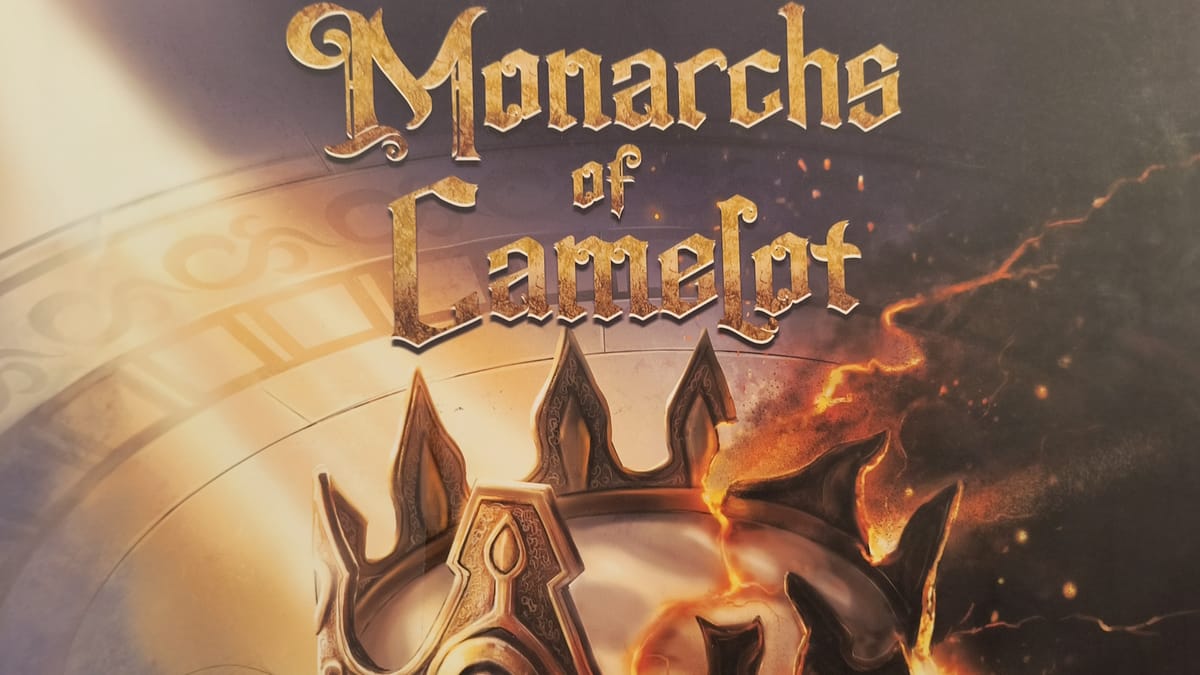
King Arthur has been slain by Mordred, and the Empire of Britain is leaderless. His old companions and advisors all have designs for that throne. You play as one of these characters, such as the great knight Sir Lancelot, the widow queen Guinevere, the Avalon mage Nimue, and the Fae prince Oberon. Each has their own quests to fulfill that will grant them the power to take the throne. However, the enemies of Camelot will not sit idle, and their machinations must be dealt with as well. How will you rule?
Monarchs of Camelot is a political storytelling card game for 2-4 players, published by Rhapsody Games. Each player chooses 1 of 4 potential contenders of Camelot’s throne, as they navigate their own unique quests, as well as the political story line of the game. Each player uses their own strategy and strengths to vie for 10 prestige points, winning the game. If I was pressed to describe the game in comparisons, I would say it’s a mixture of King’s Dilemma’s decision making and storytelling mechanics, with the wild asymmetry of Villainous.

Each character is made up of a deck of cards, which are split between two possible personas the monarch can take on. Each side of a card provides different actions, resources, and abilities. These different options will typically work primarily towards one of the two quests that the monarch has available. However, working both sides can also be an important strategy, as one side or the other typically focuses on generating only half of the resources you might need. For example, Guinevere can focus on being the successor to Arthur’s legacy, which involves dealing with unruly suitors, or can fall into despair and bereavement and turn into the White Lady, a potent warrior witch whose goal is to take Camelot by force. The White Lady form offers many soldiers and magic, as well as many aggressive actions, while the Empress form allows for more advisors and economy. The artwork evokes these decisions, as each card’s art is split in half, each showing the inevitable transformation.
So with these Decision cards in hand, each player will take turns, choosing one side of a card to slide behind their character, and then take each instant action left revealed on that card. In addition, they may take any number of actions that require resources across all of their cards by placing one of their resources on that card, or special actions related to the location the game has taken the players to. The strategy comes in using move actions to move resources off of your cards to use those actions again. Each player has a character standee as well, which is something of a wild resource, but it is also required to be used in powerful character-only actions.

Once a character has played 4 Decision cards in a single direction, your leader transforms into their Height of Power form, replacing their character card with the transformation card matching the face of the 4 cards they played. This grants them a powerful character ability, as well as freeing their standee to immediately use it. However, it forever locks them out of playing cards in the other direction, limiting their options in exchange for giving them more specific tools for solving the quest associated with that transformation.
Each quest has unique requirements, and uses different resources across the board. In addition, each quest offers opponents unique ways to sabotage them. For instance Nimue seeks out powerful relics to aid her bid for the throne, but other players can buy them from the collector before she gets her hands on them, or instead gather power to become the legendary Lady of the Lake, using that power to take over the kingdom by force.

In addition to these squabbles over personal power, an ongoing narrative pushes the game towards an inevitable conclusion. Each of the 10 story lines can diverge or converge into numerous possible outcomes, allowing an absurd amount of replayability for the story, even when playing the same scenario. Each scenario ends with a major clash, providing a way towards some of the highest prestige rewards available. Each of the story beats for this political narrative is punctuated by a location represented by a book of several such locations.
The quality of artwork and components in the preview copy we received was quite high, though typical translation issues did exist in the story cards and rule book. The sheer ambition of a game as wildly asymmetric as this one is mind boggling. If Rhapsody Games continues working on balancing each character, and streamlines the more fiddly rules, then this could be quite a unique item for anyone’s collection.
Monarchs of Camelot will be riding onto Kickstarter on November 21st. If you’re interested in a highly asymmetric political story-telling game, this is one to look out for.
